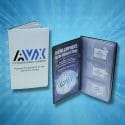source: AVX news
Comprised of a broad sampling of passives, the new IoT design kit provides engineers with a broad range of component solutions ideally suited for IoT devices with widely varying power, data processing speed, form factor, & price requirements
FOUNTAIN INN, S.C. (May 15, 2017) – AVX Corporation, a leading manufacturer and supplier of passive components and interconnect solutions, has released a new IoT design kit. Comprised of a broad sampling of passive components ideally suited for use in the three primary IoT device networks — input voltage filtering and decoupling networks, timing device networks, and output impedance RF matching networks — the new Passive Components for the Internet of Things Design Kit (Part Number: KIT-IOT) allows engineers to quickly identify effective solutions for IoT devices with widely varying requirements for power, data-processing speed, form factor, and price, among other specifications.
The new Passive IoT Design Kit contains RF microwave components, including: capacitors, inductors, circuit protection, and SAW filters; input voltage filtering and decoupling devices, including: filter capacitors and low profile power inductors; and small, high precision crystal products, including: MHz crystal units, tuning fork crystal units, clock oscillators, temperature compensated crystal oscillators (TCXOs), and capacitors for crystal unit loading. Designed for maximum efficiency, the comprehensive passive component sampling successfully addresses the needs of a wide span of IoT applications, including: wearable devices, such as fitness accessories; smart-home applications, like automated lighting and heating systems; medical electronics; industrial automation tasks, such as remote servicing and predictive maintenance; connected cars; and traffic control and other smart city applications.
Component solutions ideal for use in the input voltage filtering and decoupling networks of IoT devices represented in the Passive IoT Design Kit include:
- TCN Series Highest CV/cc Conductive Polymer Undertab Chip Capacitors
- TCJ Series Industry’s Highest Voltage Polymer Capacitors for 100V Applications to 125°C
- High-CV X5R MLCCs
- LMLP (Style C) Series Low-Profile SMD Power Inductors
Solutions for the output impedance matching networks of IoT RF antennas represented in the kit include:
- U Series Ultra Low ESR RF/Microwave C0G (NP0) Chip Capacitors
- LCMC Series Multilayer Ceramic Chip Inductors
- AntennaGuard Sub pF Varistors (SPVs)
- SAW Filters and Duplexers
These RF/Microwave components are especially well suited for use in telecommunications, GPS, WLAN, and industrial/scientific/medical (ISM) band IoT applications, and also offer Modelithics® highly accurate, substrate scalable equivalent circuit models, which help speed up design decisions and circuit level optimizations when used in combination with the industry’s leading electronic design automation tools.
The crystal components in the Passive IoT Design Kit prove particularly useful in IoT applications that require tight frequency stability, including: clock management, microprocessor control units (MCUs), application processors, and wireless applications, such as Bluetooth® low energy (BLE), WIFI, and GPS. Additionally, since Kyocera is the only company with a vertical, in-house supply chain of synthetic quartz crystals, crystal units, and ceramic packages, and AVX is a member of the Kyocera group, these products also deliver extremely competitive ROI. Timing device network solutions represented in the Passive IoT Design Kit include:
- CX2016DB Series Ultraminiature, Low-Profile SMT Crystal Units
- ST3215SB Series Ultra-Small, Low-Profile kHz Range Tuning Fork Crystal Devices
- U Series Low ESR, Tight-Tolerance C0G (NP0) Capacitors for Crystal Unit Loading.































